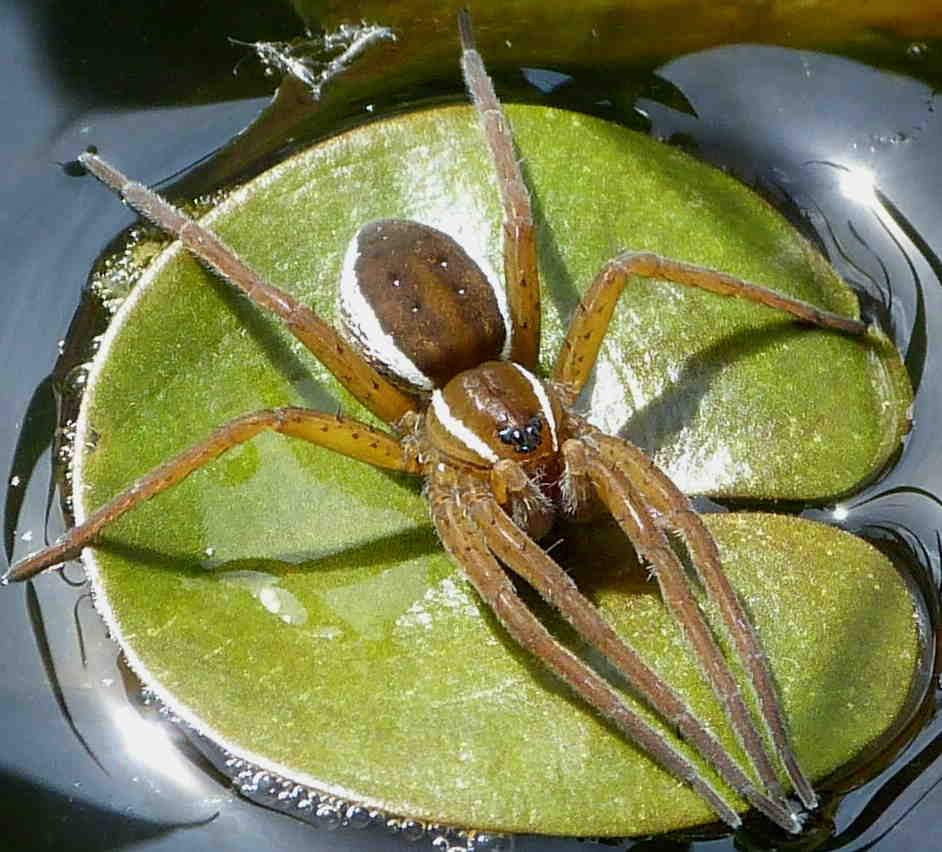To help meet the Action Plan target of reducing the vulnerability of Dolomedes plantarius to extinction in Britain by increasing the number of sustainable populations from three to 12 (below), spiders have been translocated to suitable areas of restored habitat. Following international (IUCN/SSC 2013) and national guidelines (DEFRA 2021, JCCBI 2010), assessment of the appropriateness, feasibility and likelihood of the success of translocations were made between 2007 and 2010. Underpinned by this work, the spiders were introduced to four sites in the Norfolk and Suffolk Broads, in eastern England, between 2010 and 2015. Further details of the rationale, delivery and results of this work, and of future plans, are given below.
Why translocate?
Dolomedes plantarius is intrinsically very vulnerable to extinction in Britain because it is restricted to only three sites, at one of which (Redgrave and Lopham Fen) its population has extremely small over a protracted period. A Species Action Plan, first produced in 1999 and revised in 2005 and 2008, sought to address this issue with the following ambitious targets for its future status:
- an increase the overall range of D. plantarius at Redgrave and Lopham Fen National Nature Reserve, East Anglia, to 13 ha of habitat occupied three years in five by 2010, and to 65 ha by 2020.
- the number of sites with sustainable populations of D. plantarius nationally should be increased to 12 by 2020.
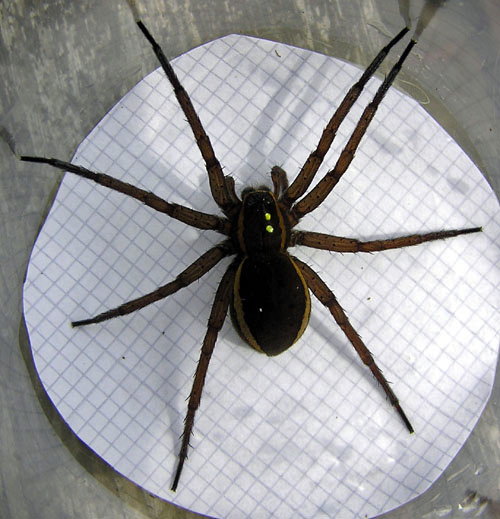
The extremely slow recovery of the remnant population at Redgrave and Lopham Fen, together with new research that highlighted the poor dispersal capability of the spiders there, showed that meeting these targets would require deliberate translocation to new sites. Pearson (2008) found that marked immature and adult spiders moved only very small distances - adult males moved further than other cohorts but only in search of females. He also found that tiny D. plantarius spiderlings, at the stage when they normally disperse from their nursery, were less likely to do so by ballooning than spiderlings of the congeneric but more common D. fimbriatus. Dolomedes plantarius spiderlings were more likely to 'rig', with their gossamer drag-lines catching on near-by vegetation, than to become fully airborne. Genetic evidence reinforced this picture of poor dispersal capacity at Redgrave and Lopham Fen. The two remnant sub-populations there, separated by a distance of around 400m including a belt of secondary woodland, were found to be genetically distinguishable (Vugdelić 2008). This strongly suggested a complete lack of mixing between them during the ca 40 years for which they are thought to have been isolated by the progressive desiccation of the fen. Critically, additional information from DNA extracted largely from moulted skins collected from this site between 1990 and 2008, showed a significant decline in the genetic diversity of this population (Holmes 2008).
Overall, the research suggested strongly that establishment of new populations was likely to be essential to ensuring the long-term future of D. plantarius in Britain. This species would be unable to colonise suitably restored habitats at significant distance from the remnant sites without a helping hand. Moreover, the window of opportunity for this intervention was closing rapidly - the loss of genetic diversity showed that the spiders, at least at Redgrave and Lopham Fen, were increasingly less able to adapt to future challenges. In response, Natural England, at the time the lead organisation for the Action Plan for this species, in consultation with the project Steering Group (then comprising Suffolk and Sussex Wildlife Trusts, the Broads Authority, RSPB, the British Arachnological Society, Buglife and Nottingham University), committed to starting as assessment of the appropriateness and feasibility of a translocation programme using the criteria laid down in guidelines produced by the IUCN (IUCN/SSC 2013), and Invertebrate Link (JCCBI 2010).
Preparation for the translocation programme
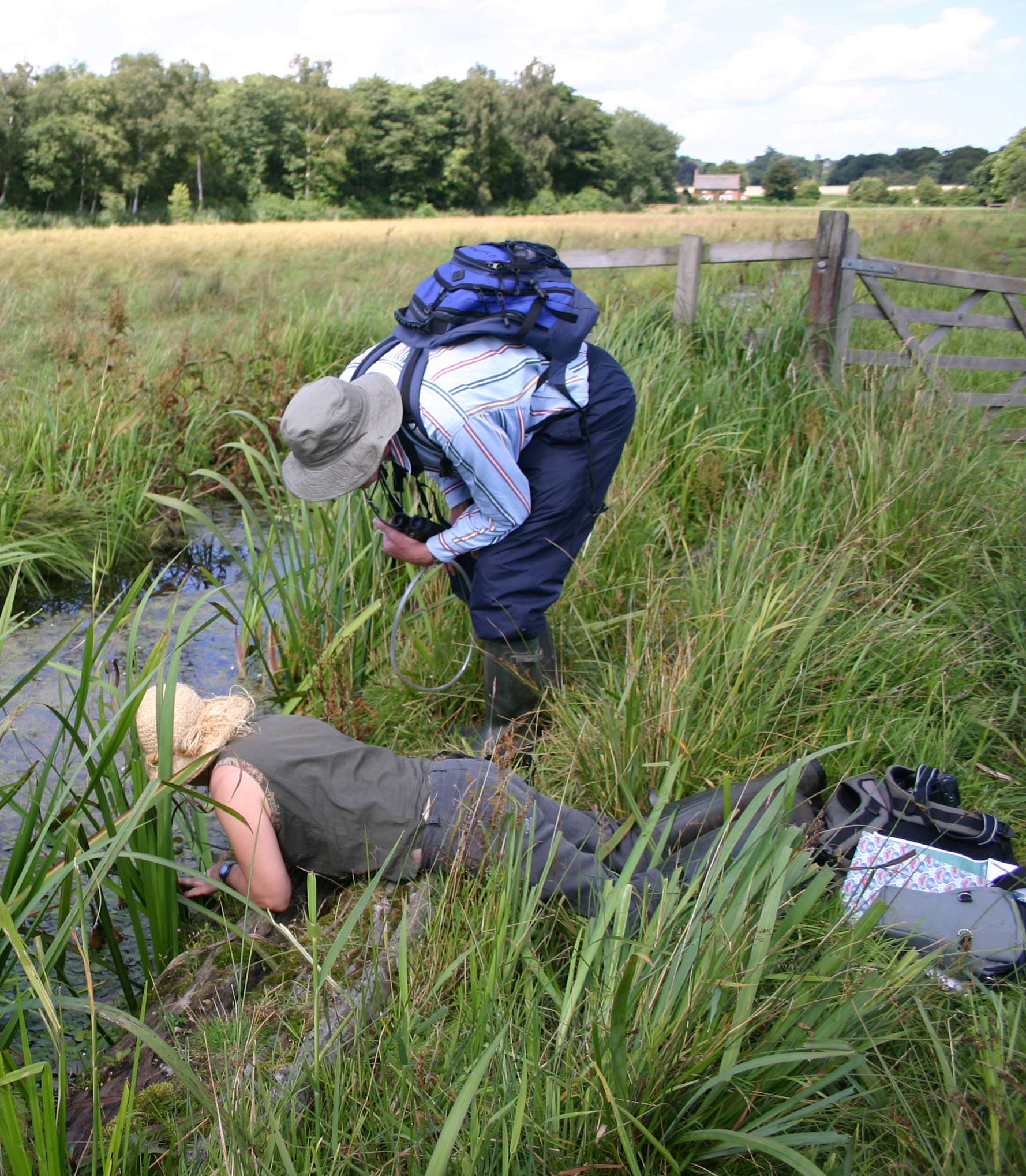
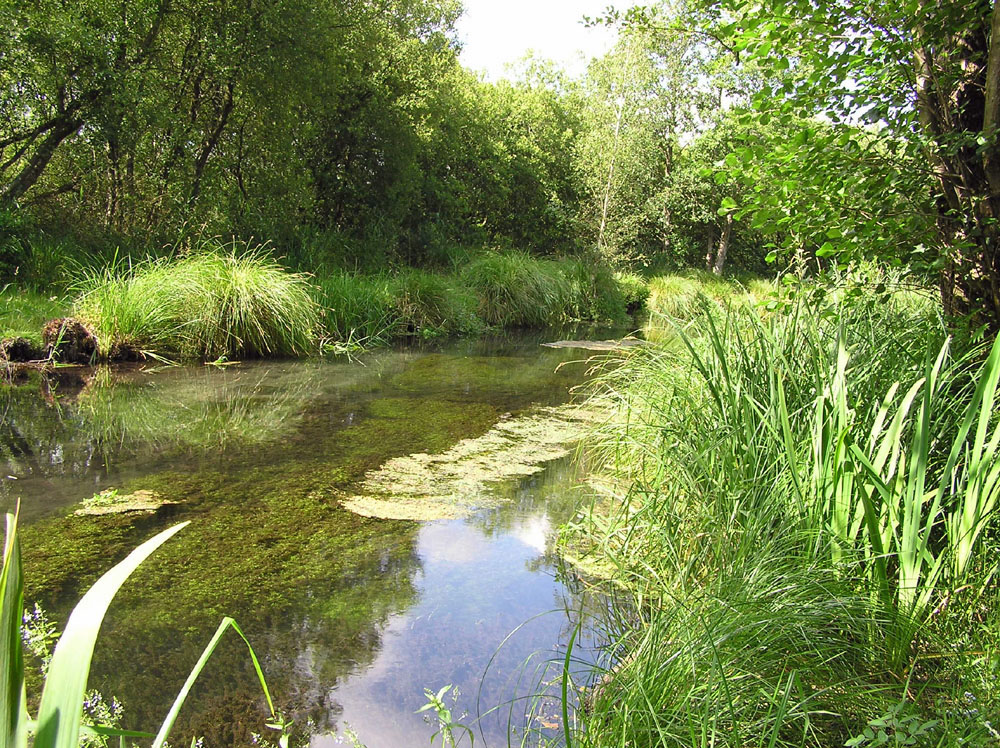
During 2008 and 2009 British Arachnological Society experts surveyed potentially suitable habitat to ensure, as far as possible, that our current understanding of the UK distribution of D. plantarius was correct and that major populations were unlikely to have been overlooked or misidentified. Their work was augmented by appeals for Dolomedes sightings through articles in specialist magazines, a Broads Authority identification card issued to those working in the wetlands of the Norfolk and Suffolk Broads, and through this website. As a result of this work and of continuing vigilance since then, new populations of D. fimbriatus but not of D. plantarius were discovered.
The search for overlooked populations simultaneously facilitated the identification of potential new sites. As well as appropriate habitat and hydrology, these had to have a guarantee of continuity of management to maintain both of these assets in the medium term. In effect this restricted the choice to nature reserves and other protected sites. Habitat extent and continuity was another important criterion. To capitalize on the investment, and to avoid any need to a 'gardening' approach to future management, new populations established by translocation had to have substantial scope to expand their ranges unaided. Already extensive areas, and areas where the acquisition of landscape-scale connectivity was being actively pursued, were ideal.
A more difficult criterion for new sites was geographical appropriateness. Guidelines for translocation suggest that sites within the historic range are most appropriate but, for a species where this is poorly known, and in view of the rapidly increasing impact of climate change on wetlands, this requires careful evaluation. Although sites roughly within the triangle defined by the three remnant populations, in South Wales, East Sussex and East Anglia, may approximately delineate a minimum historical range, this species' continental European range extends will into Scandinavia, and so sites further north may well be appropriate. A need to consider more northerly sites is also suggested by climate change models for D. plantarius which suggest that climatic conditions for the south coast and Broadland sites are likely to become unfavourable within the next 50 years (Leroy et al. 2013). In practice, however, climate change may render these areas unsuitable on a much shorter time-scale. The increasing frequency of severe summer drought threatens the spider's future at Redgrave and Lopham Fen while rising sea levels and an increasing frequency of storm surge tides threatens the low-lying land of the Broads with salinisation.
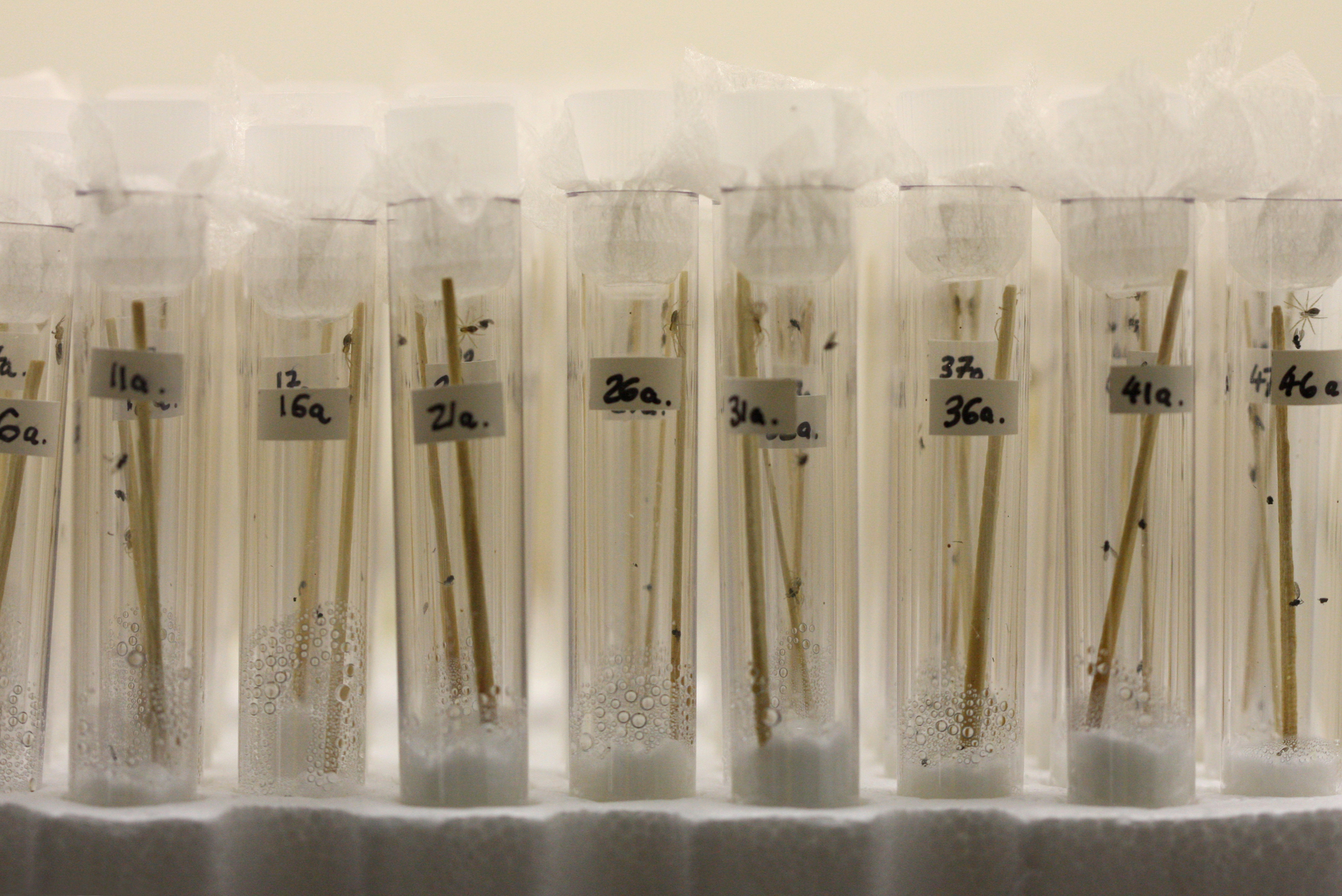
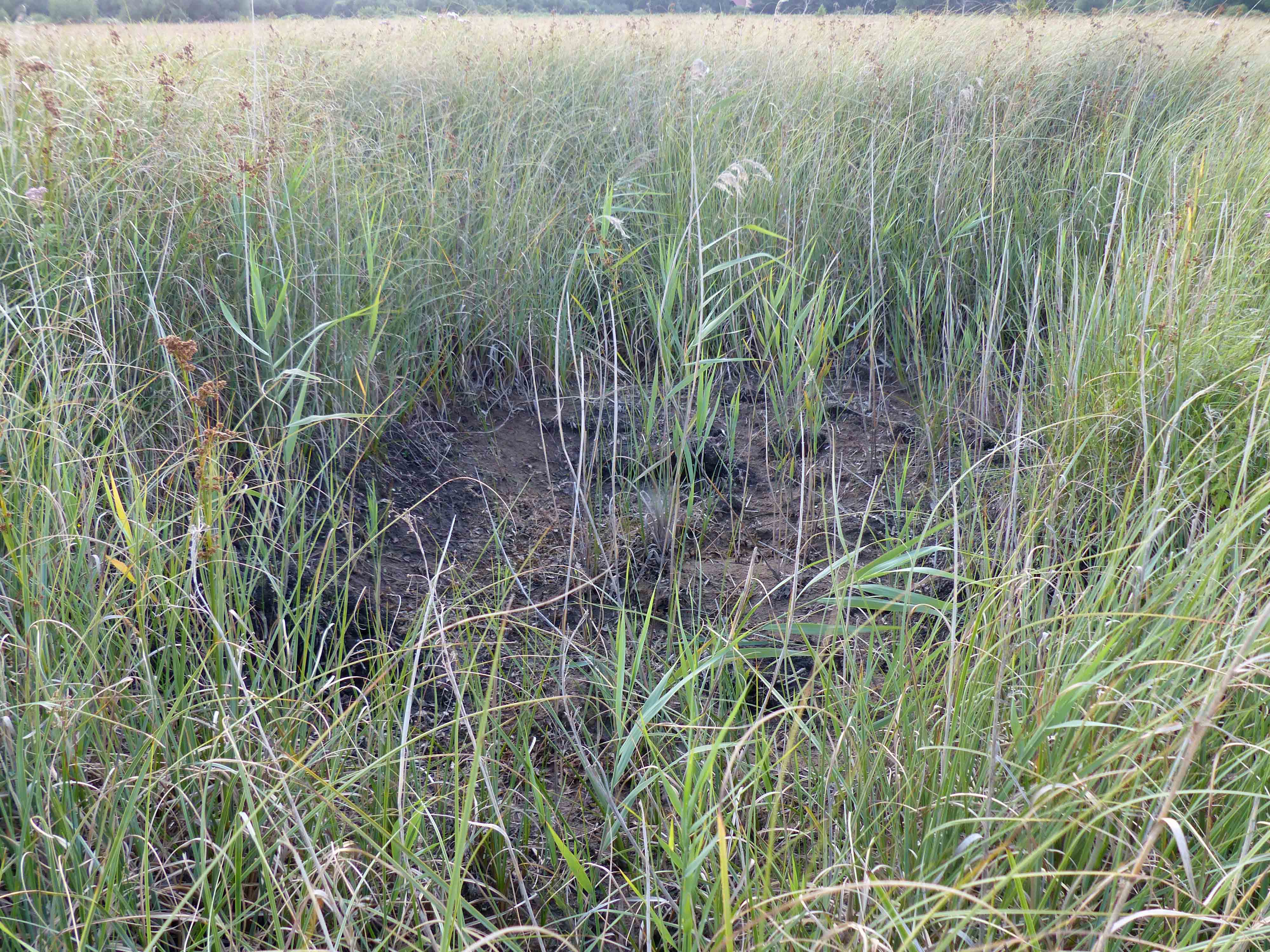
Over the same period, techniques for rearing newly-hatched D. plantarius in captivity were tested at the John Innes Centre Insectory, Norwich. Because the D. plantarius population at Redgrave and Lopham Fen was so small, direct removal of spiders for translocation was not considered to be a viable option. However, this work, and subsequent captive rearing trials, showed that rearing of the progeny of adults females, captured with egg sacs, for the first few months of life, yielded survival rates often in excess of 90%. Survival of tiny spiderlings over the same period in the wild is almost certainly very low indeed. This meant that the source population could be reinforced at the same time as a new population is established; a proportion of the reared spiderlings, and also the captive adult females with their second broods, could be released. Successful production of second broods in the wild is uncommon in the Redgrave and Lopham Fen population but reliable among captive females. Pearson (2008) found that little over 10% of females there produced second broods in 2006 and 2007, almost certainly because rapid drawn-down of water levels leaves them without suitable emergent vegetation structure. Females were returned to the wild with their second brood of hatched spiderlings in preference to releasing them when still carrying their egg sacs and risking both mother and progeny succumbing to a single predation incident.
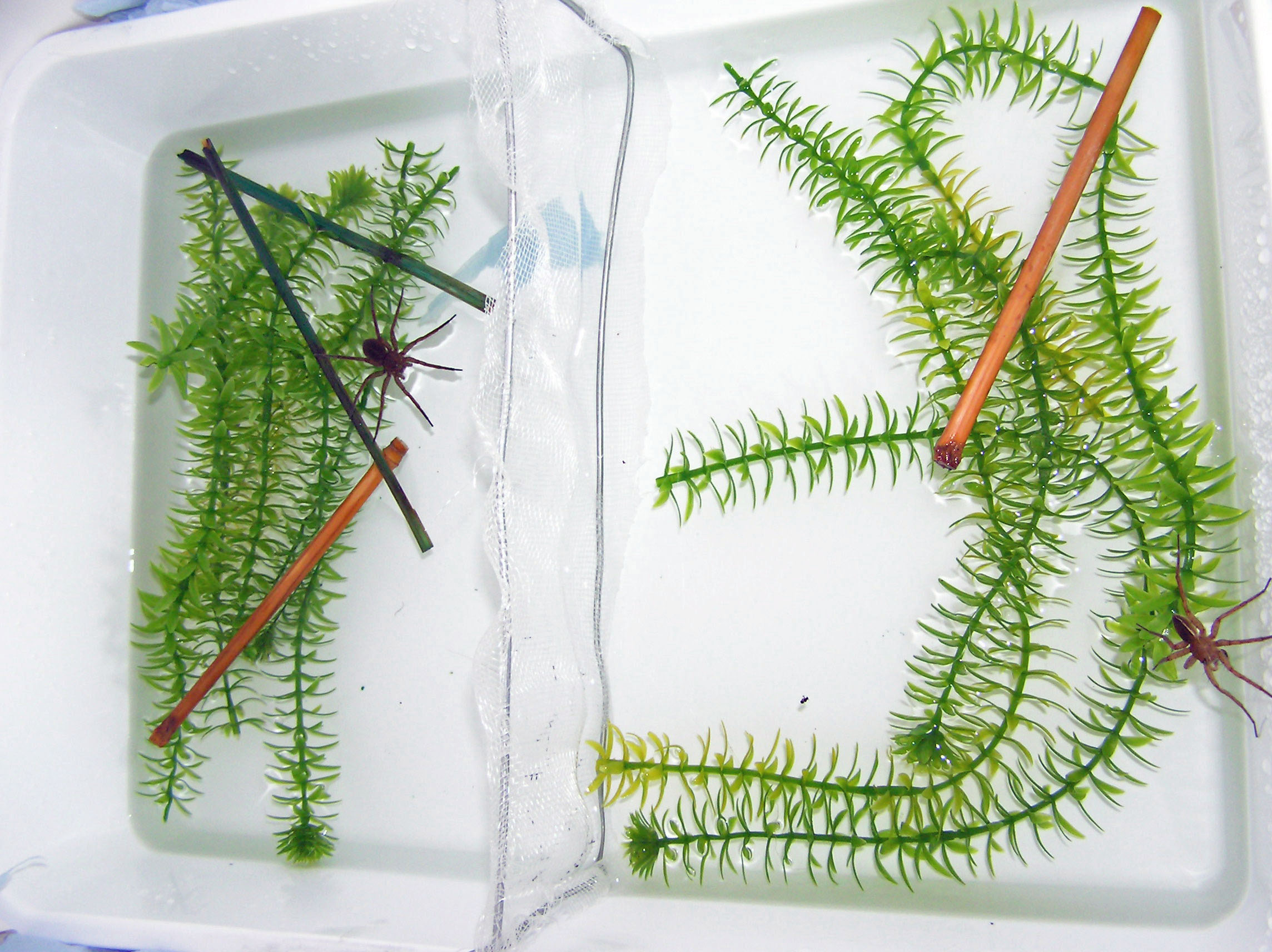
An experimental approach was taken to determining the most appropriate provenance of D. plantarius for use at new sites. The choice was between one or other of the two English populations, or both sites. Genetic research had shown differences between these populations - and between these and the Welsh and other European populations (Vugdelić 2006). Although combining long-isolated populations to maximize genetic diversity by might be expected to give new populations the best chances of adapting to their new circumstances and to future environmental challenges, the outcomes of mixing are not reliably predictable. Because of this, an evaluation was undertaken to look for any evidence of deleterious effects. An experiment was in 2010 compared courtship and mating behaviour, fecundity, and survival and growth of progeny, in crosses between and within the two English D. plantarius populations. Sub-adult spiders collected under license from the Sussex Wildlife Trust's nature reserve on the Pevensey Levels and the Suffolk Wildlife Trust's Redgrave and Lopham Fen nature reserve were matured in captivity. Once adult, within and between population matings were set up in an artificial arena in which all aspects of courtship behaviour could be observed and recorded. Fecundity, and the growth and survival of the resulting progeny over a 15 week period, were measured. No mating barriers between the populations were detected and subsequent rearing of the resulting offspring - from 18 successful parings - showed that spiderlings from crosses between populations were as successful as those from within-populations.
On the basis of this preparatory work, in spring 2010 the project Steering Group reviewed the case for translocation and concluded that translocations of D. plantarius should go ahead in England. As yet, there is no translocation programme in Wales, where NRW (then CCW) concluded that further survey and monitoring was needed to inform decisions on whether translocation there is necessary or appropriate.
The new sites
In October 2010, all of the D. plantarius spiderlings produced by the experiment to evaluate the effects of mixing donor populations were used to establish the UK's first new population of this species. The Steering Group approved the release of all of the spiderlings produced as a result of the above experiment - both the between population crosses and those of pure Pevensey Levels and Redgrave and Lopham Fen origin.
Castle Marshes
The site chosen for this first release was Suffolk Wildlife Trust's Castle Marshes reserve, part of an internationally important complex of grazing marshes on the River Waveney, downstream from Redgrave and Lopham Fen at the source of the river. It is highly unlikely that this species did not, historically, have a continuous population throughout the length of the river before being lost from the grazing marshes as the quality of the ditches was degraded by conversion of the marshes to arable agriculture. The ditches have now been restored and support a rich assemblage of invertebrates and plants, very similar indeed to those on the Pevensey Levels, the spider's stronghold on the south coast of England. In many respects the lower Waveney marshes are very much more similar to the Pevensey Levels than to Redgrave and Lopham Fen, making even more appropriate the release there of stock from both sites.
In addition to releasing around 2,800 spiderlings at Castle Marshes, over 1,900 spiderlings of single-site provenance were returned to their natal populations on the the Pevensey Levels and at Redgrave and Lopham Fen. In the latter case, this not only to boosted numbers in the two small areas to which they had become confined, but was also used to create a new, third focus for the population within the nature reserve. In 2011, a second and final introduction of spiderlings was made at both of these sites.
Carlton Marshes
2011 also saw the founding of another new population of spiders, this time on grazing marshes just downstream from Castle Marshes, at Suffolk Wildlife Trust's Carlton Marshes nature reserve. This population was again established with spiderlings from both Redgrave and Lopham Fen and the Pevensey Levels. Those from the former site were again hand-reared in test tubes to minimise depletion of the fragile population there. Those from Pevensey were collected from areas of very high population density which could support limited removals. They were collected as females carrying their egg sacs and then kept in 5 l water bottles until nurseries were produced. When the spiderlings were a few days old and ready to disperse, the bottles were opened at the release site allowing the females, together with their broods, to move into in their new homes. Many of these females went on to produce second broods at the new site, later in the summer. This change in methodology, which reduced the numbers of individually-reared spiderlings, made the whole operation more viable.
Another major change in this respect was the start of a partnership between the project and BIAZA zoos and collections around the country, which took on the captive-rearing of batches of spiderlings. This new partnership, masterminded by Ian Hughes, then of Dudley Zoo, transformed the rearing operation from - very literally - a cottage industry, to a much larger-scale operation utilizing the experience and skills of a generous team of zoo staff and volunteers. Starting with four zoos in 2011, and increasing to 10 in 2013, this brought huge benefits in terms, not only of the numbers of spiderlings that could be reared, but also in expertise in developing the captive rearing methods. In addition, it brought new opportunities to raise awareness of the plight of this species, and its wetland habitats, with a huge new audience of zoo visitors. Click here for acknowledgement to all of the zoos and collections involved.
The Mid-Yare Marshes
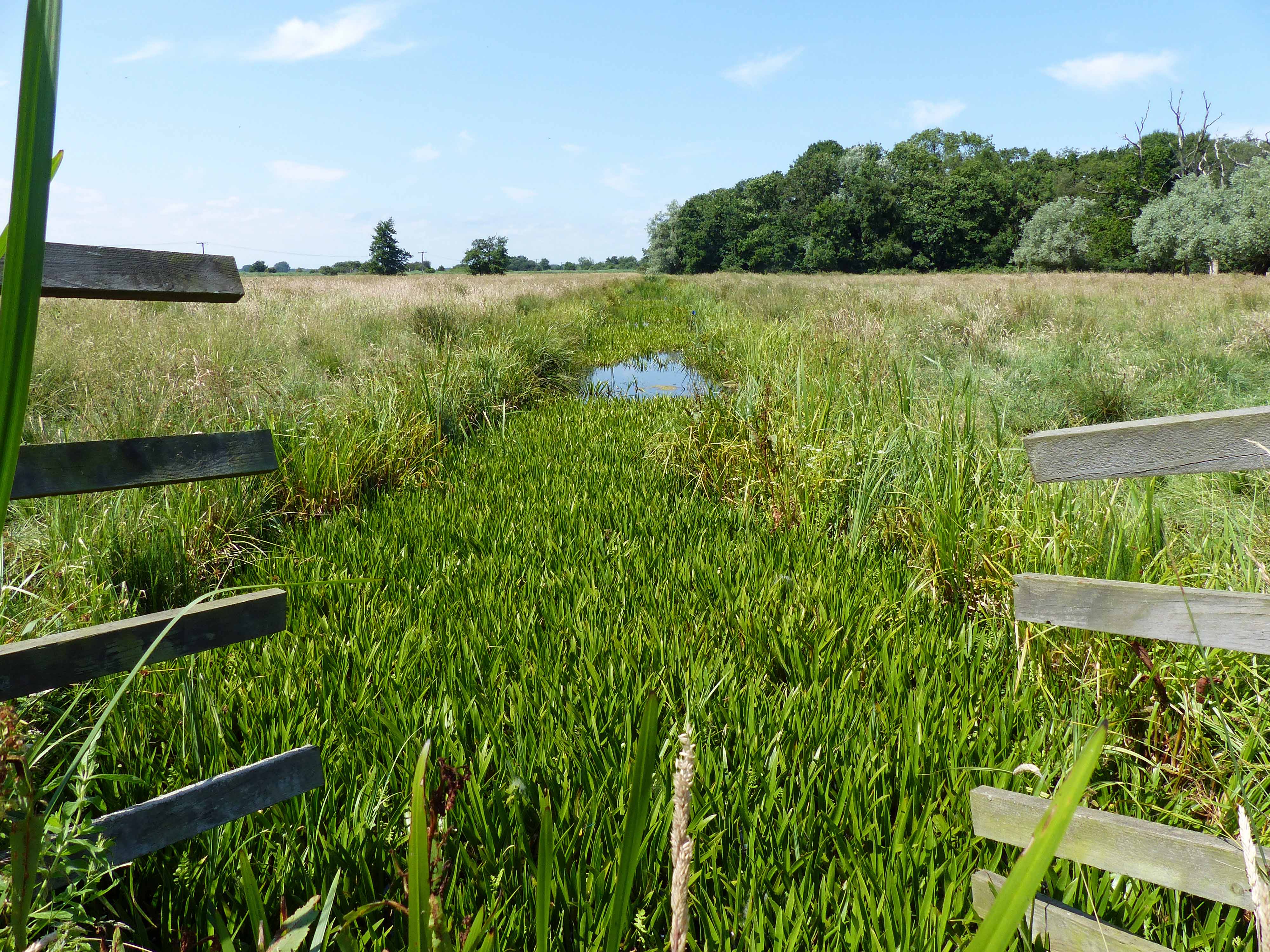
In 2012, as well as making a second introduction of spiderlings to Carlton Marshes, D. plantarius was introduced to another of the Broadland catchment rivers - the Yare. The release site was again on well-restored grazing marsh ditches. These formed part of the very extensive Mid-Yare National Nature Reserve complex managed by RSPB. The reserve includes Strumpshaw Fen at its western end and extends along an eight mile stretch of the river. This population was again established by translocation, in two successive years, of test-tube reared spiderlings from Redgrave and Lopham Fen and of 'bottled' nurseries from the Pevensey Levels. It suffered an early setback in January 2013 when storm surge breached the adjacent bank of the river Yare and flooded much of the release area with saline water. Fortunately, this event was immediately followed by very heavy rain which rapidly flushed out much of the salt. The second release of spiderlings, in 2012 was undertaken only when it was clear that some of the animals from the first introduction had survived this event and repairs to the river bank were in progress.
Ludham Marshes
In 2014 and 2015 a fourth new Broadland population was established on river Ant grazing marsh ditches that form part of the Ludham - Potter Heigham National Nature Reserve, managed by Natural England. Monitoring of the first three new populations had, by that stage, shown that these were establishing well, and in places very dense. This enabled collection of the spiders released at Ludham from the still relative new Castle Marshes population. It avoided the time, expense and depletion involved in collecting from the remnant natural populations - a major change in the previous methodology. The spiders were collected as females with egg sacs and, as with the Pevensey Levels animals in previous years, these were released to the new sites in their 'bottled' nurseries. Sadly for us all, this change also meant an end to the captive-rearing collaboration with BIAZA zoos, but it left a remarkable legacy of success as well as a potential model for other translocation programmes.
Assessing the new populations
Monitoring methods
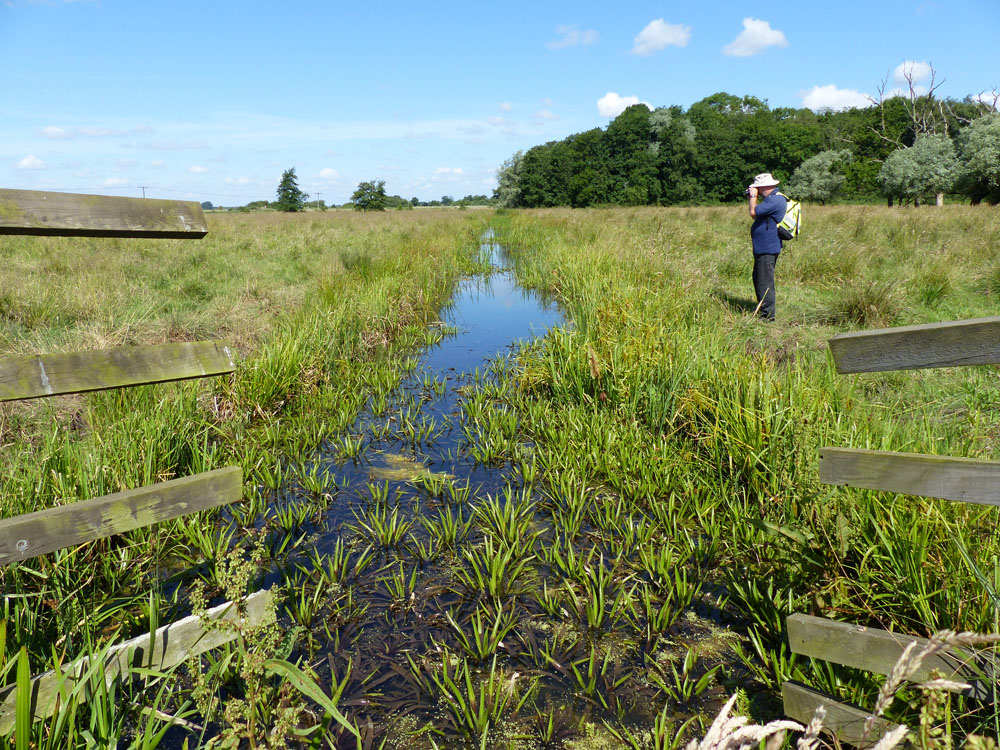
Monitoring the progress of the new populations is an integral and essential part of the translocation process. As well as tracking changes in their density and aerial extent, it informs any need for augmentation, or for changes in methodology - such as that implemented at Ludham-Potter Heigham in 2014 (above). In the event of failure of a translocation, it becomes critical to understanding what went wrong and why.
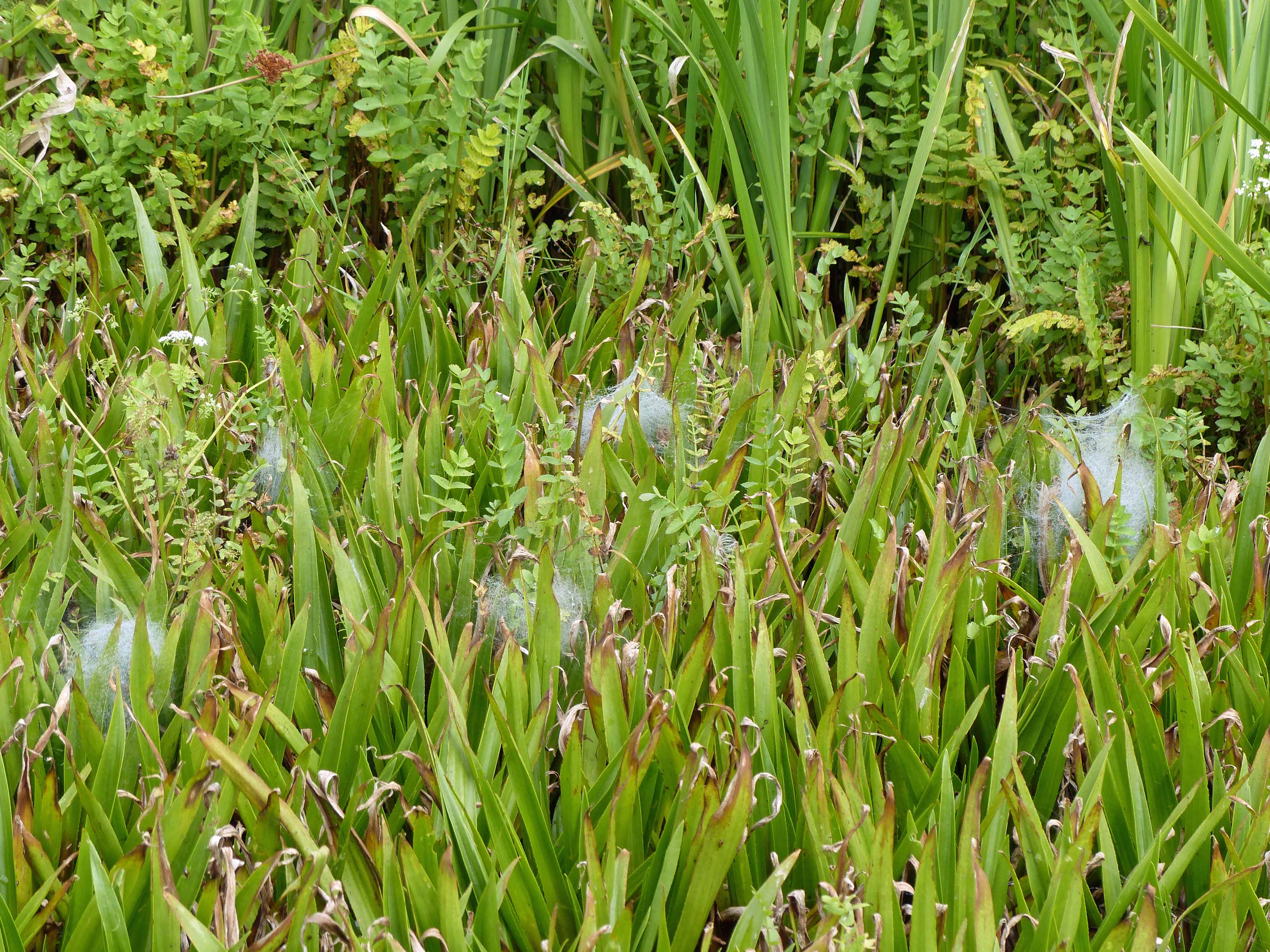
For the new, grazing marsh D. plantarius populations, counts of nursery webs are used as the main metric of population size. Unlike the spiders themselves, they have the advantage of being static and, usually, very visible. Although counts of nurseries do not equate to adult female population size because each female can produce more than one nursery during the season, they do provide a consistent population index. As the new populations establish, our monitoring aims to track changes in density on individual sections of ditch, and changes in the range of the populations as new ditches are colonised. Counts are made of all nursery webs encountered, as far as possible at weekly intervals. The condition of each web is noted - whether occupied by the spiderlings or abandoned in various stages of disintegration. Because spiderlings remain in the nursery for around five days, occupied webs at each visit could be assumed to be new since the previous week. This also gives the potential to obtained a more accurate reflection of actual nursery numbers by adjusting these weekly minimum counts for the numbers of nurseries likely to have been both built and abandoned between counts. Such estimates can be validated independently for ditches where densities are low and nurseries can be individually identified.
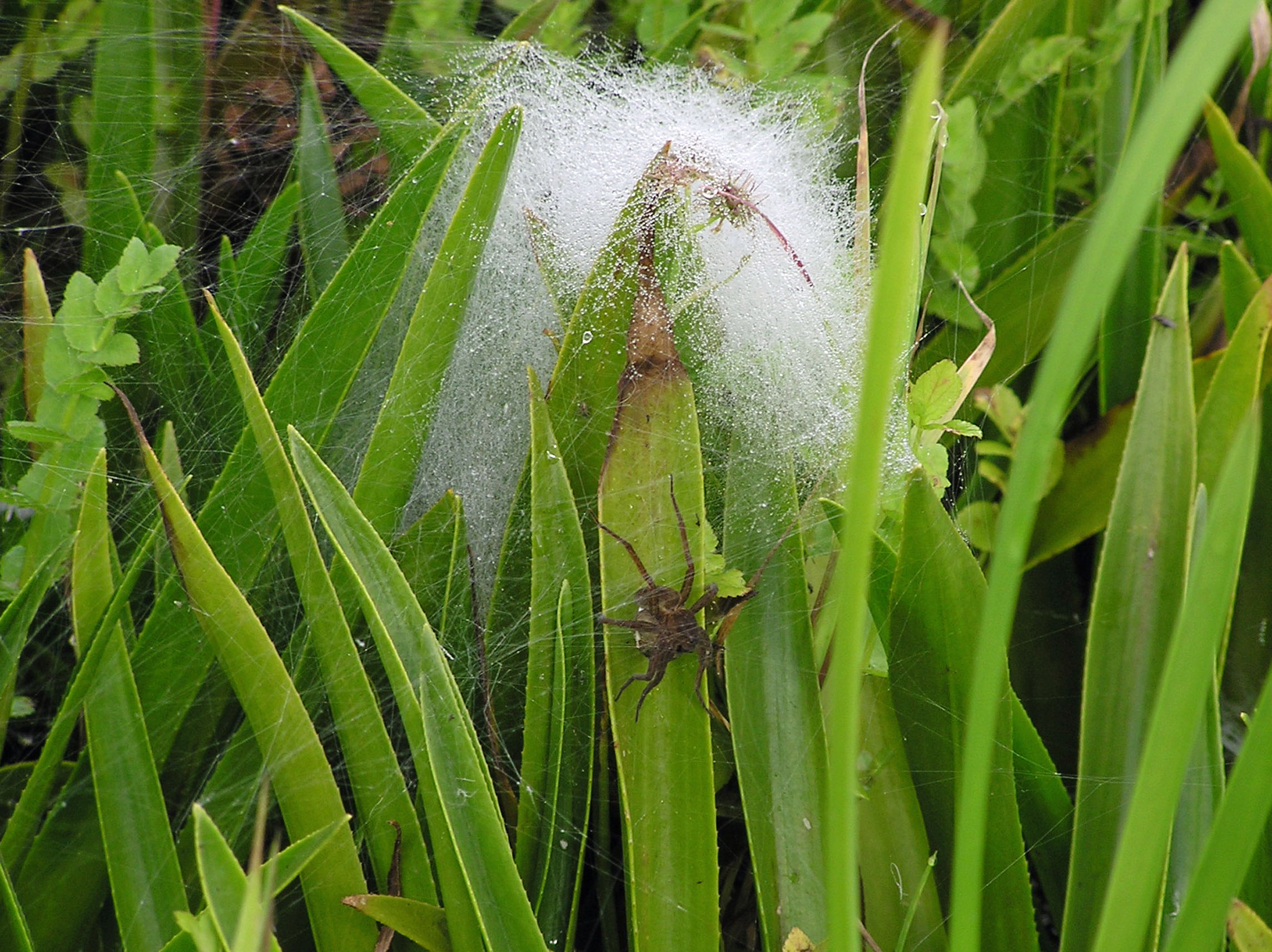
Although nurseries appear to provide a relatively straightforward metric, the behaviour of the spiders often makes counting, and the interpretation of counts, more complex. Nurseries can often be build in very close proximity, with parts of their scaffolding shared in common. These high density aggregations arise because females with egg sacs often to seek shelter under the protective framework of abandoned nurseries, and occasionally within still-occupied ones. They go on to build their own nurseries within the same structure, giving the impression that a nursery is occupied for a much longer period than is really the case. These clusters are further perpetuated through the season by the tendency of individual females to build second brood nurseries at the same location as their first.
A different type of issue with monitoring the new populations arises from lack of funding - although an integral element in the success of a translocation programme, monitoring is a much less attractive proposition to funders than the initial, high profile work to establish a new population of an endangered species. Monitoring of all of the new D. plantarius populations is being achieved largely through the hard work and dedication of teams of local volunteers, with some welcome funding support, particularly for training. Inevitably, the collection of data tends to be less consistent with entirely voluntary teams, presenting challenges for analysis and interpretation.
Monitoring results
Castle Marshes
This, first, new population has been the most consistently monitored, with weekly counts maintained through the seasons by the same surveyor until the end of 2019. It showed rapid population growth, with numbers leveling off after seven years, in 2018 (Lower Waveney 1 on chart below). A slight dip in numbers in 2014 reflected a decline in density on a single ditch which, until that point had had exceptionally high numbers forming a high proportion of the total for the site. This ditch became relatively insignificant in the totals after 2014, as the spiders rapidly colonized more ditches throughout the site. The plateauing of numbers after 2017 reflects the colonisation of virtually all of the site's ditches. Annual variation in numbers from this point are likely to reflect changes in the suitability of individual ditches for the spiders, in terms of vegetation type and water quality. Although the leveling-off of numbers reflects the situation on the Castle Marshes nature reserve, it is likely that the population is continuing to expand beyond the reserve in areas that are not covered by our current survey. Evidence for this came in summer 2020 when a post-breeding female was found in emergent vegetation next to a fishing jetty on the river Waveney upstream of Castle Marshes. Although it was separated from the nearest ditch on which they had been recorded by only around 400 m, the intervening ground included a very wide and high river embankment, and areas of mown turf.
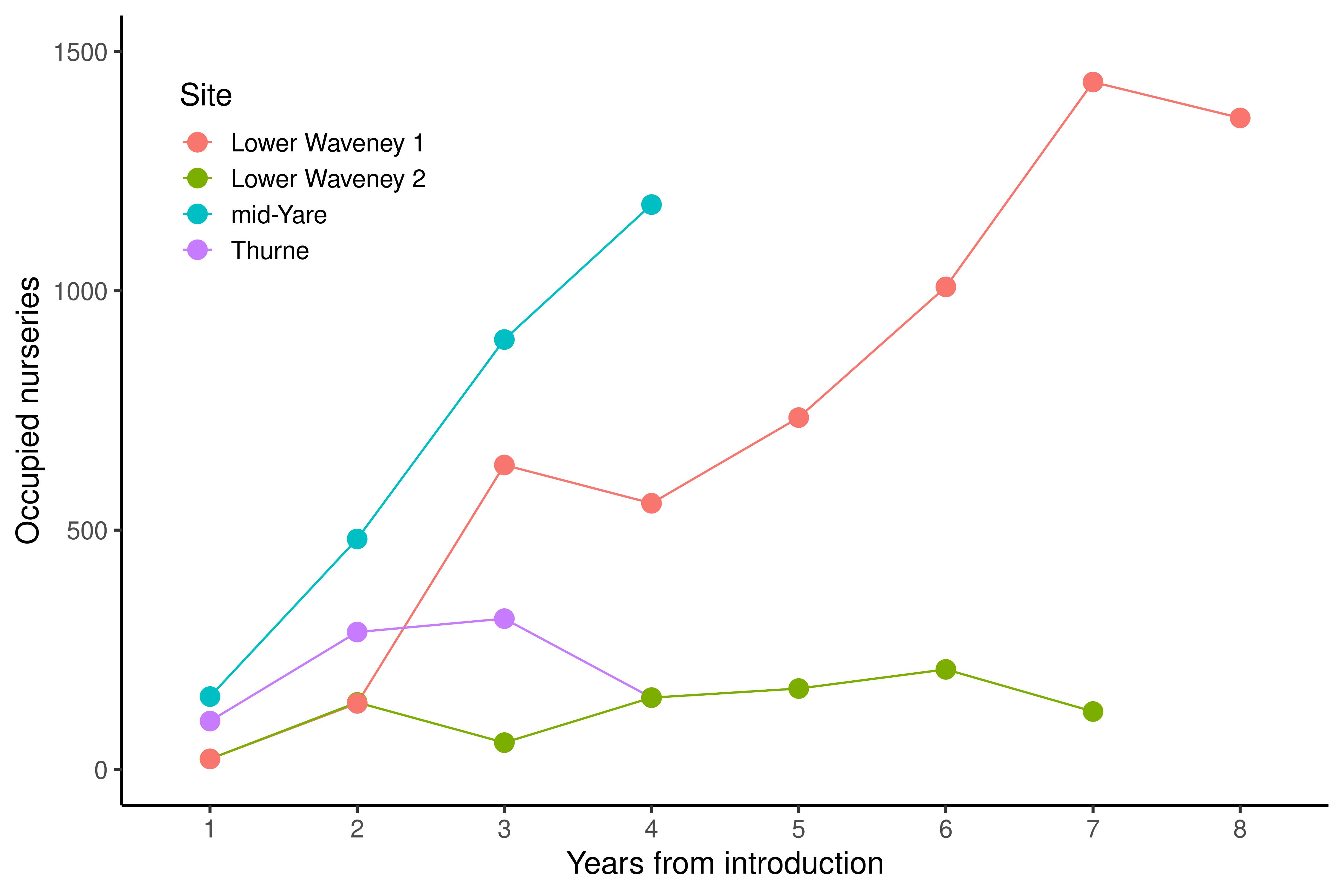
Carlton Marshes
Although only 3.4 km downstream from Castle Marshes, the trajectory of the D. plantarius population at Carlton Marshes has been very different (Lower Waveney 2 on chart above). Despite monitoring having been less consistent in timing and frequency in some years, and undertaken by a relatively high turnover of observers, the pattern of annual count totals is clear. The population is only around a tenth of the size of that at Castle Marshes, and appears to be much more restricted in extent. Nevertheless, it appears to be well established and is continuing to grow slowly and to expand in range.
Mid-Yare Marshes
Like the D. plantarius population at Castle Marshes, that on the Mid-Yare marshes grew exponentially in the early years following introduction (chart above). Monitoring by the same, small volunteer team kept track of nurseries numbers at weekly intervals for most of the season. The survey area covered the enclave of marshes where the spiders were released on selected ditches sections in 2012 and 2013. This is separated from the main expanse of marshes adjacent to the river Yare by an embanked railway line. The only aquatic connection between them was via a single culvert under the embankment. In May 2017 spiders were found, for the first time, south of the railway embankment and later survey of ditches in this area during the peak breeding season revealed that an extensive area was already colonised. With this discovery, survey effort was diverted to the wider expanse of marshes. Investment in the original survey was reduced, with counts made fortnightly rather than weekly in 2018. In 2019, monitoring work was restricted to a wide-scale survey, which showed the rapidly expanding population advancing at a estimated rate of around 200 m a year (RSPB data). Although the constraints of Covid-19 situation prevented a repeat of this survey in 2020, the exciting discovery of a female with an egg sac on a ditch 2 km from the last recorded position, showed that, as at Castle Marshes, the monitoring scheme now needs further review and modification.
Ludham Marshes
This most recent of the new D. plantarius populations has followed a pattern of growth more similar to that at Carlton Marshes, with a slow-growing, low density population (Thurne on chart above). Regular monitoring, from a small local team, shows a gradual increase in numbers, although the increase in range is more rapid. A slight decrease in overall numbers in 2019 probably reflected a decline in suitability of what had been the highest density ditches, as a result of vegetation change. As at other sites, the relatively rapid expansion in range requires review and modification of the monitoring strategy.
Interpreting the results
All four of the new D. plantarius populations established by translocation of spiderlings of mixed provenance are thriving. None has required any augmentation after the first planned releases and all are growing both in numbers and extent.Two have grown exponentially during their establishment years while the other two have grown much more slowly. This difference is helping to inform understanding of the drivers of population growth.
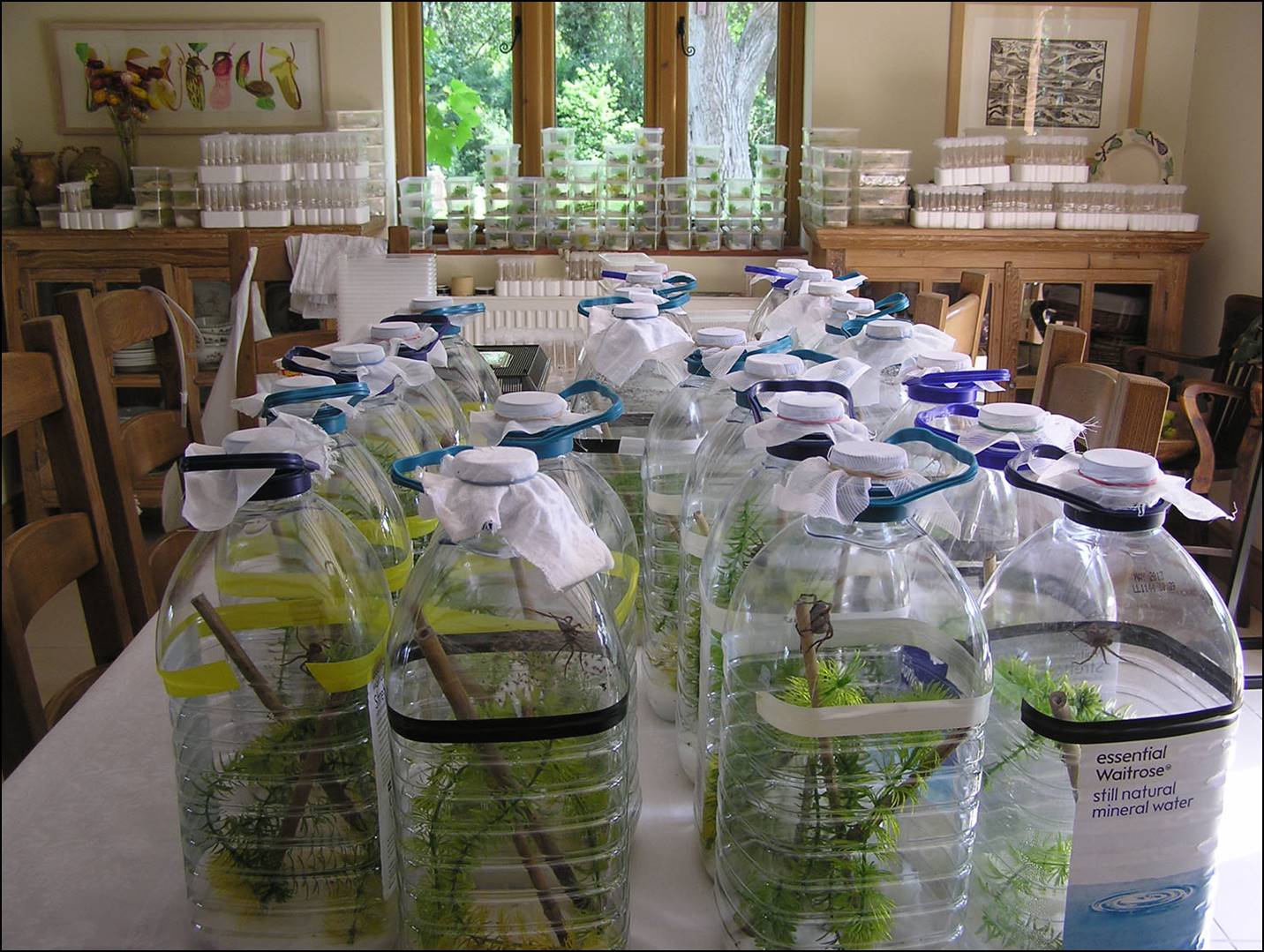
The initial success of establishment is likely to be due, at least in part, to the very large numbers of spiderlings released. In total, around 6,000 hand-reared, three-month old spiderlings from Redgrave and Lopham Fen were released, along with 56 adult females with their nurseries from the Pevensey Levels. The latter contributed around a further 25,000 week-old spiderlings, inevitably with lower survival chances than the older, hand-reared stock.
In addition to the large numbers of spiderlings released, several factors, all of which are under further investigation, appear to be contributing to the rapid establishment and growth of the new populations:
- the annual phenology of nursery production shows clearly that a high proportion of female D. plantarius produce second broods on the grazing marsh sites, with two peaks at the normal inter-brood interval of ca 5 weeks. In comparison with Redgrave and Lopham Fen, where second broods are rare, this is a very significant increase in fecundity and potential population growth rate. In 2014, when the season was protracted by an early spring, the phenology suggests that some females went on to produce a third brood. The clarity of these peaks varies between years depending on the synchrony of the start of the breeding season. Although relatively late recruitment to the breeding population by a proportion of females must account for some of the variation, this is limited by the need for females to mate before most of the males die, usually during July.
- the releases of spiderlings on the grazing marsh sites showed that at least some females mature and breed in their second year, further increasing the rate of population growth. At Redgrave and Lopham Fen, and in captivity, females appear to breed in their third year.
- for a number of reasons, the mobility of the spiders appears to be much greater on the grazing marshes than at Redgrave & Lopham Fen. Compared with turf ponds embedded in a dense and often dry matrix of tall sedge, the interlinked grazing marsh ditch networks facilitate water-surface travel, including by 'sailing' (see Locomotion) and being blown along on floating mats and fragments of vegetation. The relative lack of tall vegetation, and the usually close-grazed fields between the ditches, also present less of an obstacle to ballooning spiders.
- the saw-toothed leaves of the spiky, floating rosettes of Stratiotes aloides (Water Solider), which, in places, completely cover the grazing marsh ditch surfaces, quickly emerged as an important driver of D. plantarius population density. This species provides an ideal support for nursery web construction. When growing densely, it effectively doubles the area available for nursery web construction and is also likely to have advantages for protection against predators and for foraging. Because the rosettes float, they additionally provide the perfect support when water levels fall or rise, maintaining the height of the nursery above the water surface. Its importance was illustrated Castle Marshes, where ditches with dense cover of S. aloides supported, respectively, 6.4 and 8.4 times more nurseries than those without in 2016 and 2017 respectively (Smith 2018).
Higher fecundity and greater mobility of D. plantarius appear to be reliable advantages of grazing marshes as host sites for new populations. On top of this, the presence of S. aloides can clearly be a major driver in the rapid establishment and growth of new populations. The slower growth of the populations at Carlton Marshes, and on the Ludham marshes, is likely to be due, at least in part, to smaller and much less predictable S. aloides populations there. The decline in D. plantarius population size at Ludham in 2019 for example, was restricted to ditches that lost their S. aloides cover. Statiotes aloides is a notoriously sensitive plant, often subject to sudden population crashes for reasons that remain poorly understood despite a significant volume of research on its ecological preferences. For this reason, it is likely to prove a major driver of D. plantarius population size. However, particularly once new spider populations are well established, this species is unlikely to be necessary for their persistence. Nursery webs have been recorded in well over 50 plant species at Castle Marshes and the Ludham D. plantarius population has continued to grow slowly despite a significant crash in S. aloides.
The future
By 2020 the number of D. plantarius populations in Britain had been increased from three to seven by translocation. Although this fell short of the Action Plan target of 12 by 2020, the British population of this species is already much less vulnerable to extinction and the translocation programme remains on track to deliver further new populations when and where appropriate. Although no further new releases have been made since 2015, other potential host sites, both within the Broads and further afield, are being assessed in terms of their intrinsic suitability. The future of the programme also continues to be informed by the still-developing outcomes at the first four sites.
With the increasing threat of salinization in the Broads, the inland fen basin of East Anglia is an important target area. The still relatively new, landscape-scale projects to restore arable farmland to fen around the ancient fen remnants - at Wicken (Wicken Vision), Woodwalton and Holme Fens (Great Fen), Lakenheath Fen, and Willow Tree Farm in the Lincolnshire Fens - eventually promise an area of over 20,000 ha of habitat. In addition sites further north and west are under consideration, where sea level rise and other impacts of climate change pose less of a medium term threat.
By the time D. plantarius is next reassessed for the British Red List it is hoped that it will no longer classify as threatened with extinction. However, since climate change is an increasing and existential threat to this and all other wetland rarities, its improved status cannot be taken for granted. It remains a major challenge to keep this species in the spotlight, while maintaining monitoring and finding the resources to act, if needed, to retain its new, more favourable status.
Volunteering to help monitor the new populations
Monitoring the progress of the new spider populations is critical to ensuring their success. It tells us how well they are doing in terms of numbers and changes in their range. This in turn informs the need for any interventions, including changes in site management. Differences in how well the spiders are faring, for example between different ditches within a site, and between sites, provide invaluable insights into the spider's precise requirements, in turn helping to inform conservation decision making. If you live in the vicinity of any of the British populations and are interested in helping with monitoring them, please see 'How to help'.
References and additional reading*
DEFRA 2021. Reintroductions and other conservation translocations: code and guidance for England v 1.1. Downloaded 22/02/2023
Holmes, A. 2008. The Conservation and Genetics of the Fen Raft Spider,
Dolomedes plantarius (Clerk). Masters thesis, University of Nottingham.
IUCN/SSC 2013. Guidelines for Reintroductions and Other Conservation Translocations. Version 1.0. Gland, Switzerland: IUCN Species Survival Commission, viiii + 57 pp.
JCCBI 2010. Invertebrate translocation – a code of conservation practice, Invertebrate Link (JCCBI). British Journal of Entomology and Natural History 23: 2010.
Leroy, B., Paschetta, M., Canard, A., Bakkenes, M., Isaia, M. & Ysnel, F. 2013. First assessment of effects of global change on threatened spiders: Potential impacts on Dolomedes plantarius (Clerck) and its conservation plans. Biological Conservation [online]. 161: 155-163.
Pearson, P. 2008. The ecology and conservation of the Fen Raft Spider (Dolomedes plantarius) in the UK. Ph.D. thesis, University of East Anglia.
Smith, H. 2019. Fen Raft Spiders in the Broads: final report to Love the Broads 2015-2018. Unpublished report to Love the Broads.
Smith, H. 2018: Hanging by a thread: Norfolk’s rarest spiders. Transactions of the Norfolk and Norwich Naturalists’ Society 51: 1–14.
Smith, H. 2015. Report on the Fen Raft Spider Dolomedes plantarius translocation project in 2014. Unpublished report to the Fen Raft Spider project steering group partners.
Smith, H. 2014. Report on the Fen Raft Spider Dolomedes plantarius translocation project in 2013. Unpublished report to the Fen Raft Spider project steering group partners.
Smith, H. 2013. Report on the Fen Raft Spider Dolomedes plantarius translocation project in 2012. Unpublished report to the Fen Raft Spider project steering group partners.
Smith, H. 2012. Report on the Fen Raft Spider Dolomedes plantarius translocation project in East Anglia in 2011. Unpublished report to the Fen Raft Spider project steering group partners.
Smith, H. 2009. BBC Wildlife Fund: Report on the Fen Raft Spiders for the Future project at Redgrave and Lopham Fen in 2008. Unpublished Suffolk Wildlife Trust Report.
Smith, H. 2009. Fen Raft Spider Recovery Project Progress: Report on the Translocation Project: 2008. Unpublished report to Natural England.
Smith, H. 2003. Fen Raft Spider Recovery Project: Report on the search for Dolomedes plantarius in the Broads Grazing Marshes in 2003. Unpublished report to English Nature.
Smith, H., Clarke, D., Heaver, D., Hughes, I., Pearce-Kelly, P. & Sainsbury, T. 2013. Translocation and augmentation of the fen raft spider populations in the UK. In: Soorae, P. S.(ed.) Global re-introduction perspectives: 2013: Further case studies from around the globe. IUCN/SSC Re-introduction Specialist Group and Abu Dhabi, UAE: Environment Agency-Abu Dhabi. xiv + 282 pp.
Smith, H., Baillie, S., Tilmouth, S. & Casey, D. 2011. Report to the BBC Wildlife Fund on the Waveney Fen Raft Spider project in 2010.
Vugdelić, M. 2006: Genetic relations within and amongst Dolomedes aquatic spiders. Ph.D. thesis, University of East Anglia.
* Some of the unpublished reports listed here contain confidential details. Please contact me if you would like further information on this project.
